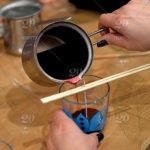Frosting can be a frustrating issue when it comes to making soy candles. It not only affects the aesthetic appeal of the final product, but it can also impact the quality and performance of the candles. In this section, we will delve into understanding what exactly frosting is and why it occurs in soy candles. By gaining a deeper understanding of this phenomenon, you will be better equipped to prevent frosting and create beautiful, professional-quality soy candles.
Frosting occurs when white crystalline patterns appear on the surface of a soy candle. These patterns can resemble frost or snowflakes, hence the name. Frosting is a natural characteristic of soy wax and is caused by the crystallization of some of its ingredients. Several factors contribute to its occurrence, including temperature fluctuations during cooling and curing, as well as changes in humidity levels.
Preventing frosting is crucial for candle makers who strive for flawless and visually appealing products. Not only does frosting affect the overall aesthetic appeal, but it can also interfere with fragrance throw and even cause issues with burning performance. By taking proactive measures to prevent frosting from occurring in your soy candles, you can ensure that your creations are not only visually stunning but also deliver an excellent sensory experience for those who use them.
In the following sections of this article, we will explore various strategies that you can employ to prevent or minimize frosting when making soy candles. From understanding the science behind soy candle frosting to selecting appropriate wax varieties and utilizing additives and fragrances specifically designed to combat frosting, we will cover all aspects necessary for achieving impeccable results in your candle-making journey. So let’s dive in.
The Science Behind Soy Candle Frosting
Understanding the science behind soy candle frosting can help candle makers better prevent this common issue. Soy wax, which is made from soybean oil, is known for its natural and eco-friendly qualities. However, it also has a tendency to develop frosting, which can detract from the aesthetics of the candles.
The composition of soy wax plays a significant role in the occurrence of frosting. Soy wax contains various natural compounds, such as fatty acids and triglycerides. When these compounds solidify and crystallize during the cooling process, they can create a frosted appearance on the surface of the candles.
Temperature and environmental factors also contribute to frosting in soy candles. Rapid or uneven cooling can promote the formation of crystals on the surface of the wax, leading to frosting. Additionally, exposure to extreme temperatures or fluctuations in temperature during storage or transportation can exacerbate frosting issues.
To prevent or minimize frosting in soy candles, it is important to choose the right soy wax variety known for its resistance to frosting. Different types of soy wax are available in the market, including container blend wax and pillar blend wax. Container blend waxes are specifically designed for jar candles and tend to exhibit less frosting compared to pillar blend waxes used for freestanding candles.
When selecting soy wax for your candle-making projects, consider factors such as melt point and additives included in the formulation that contribute to frost resistance. Some specific varieties like Golden Brands 464 Soy Wax have gained popularity among candle makers for their ability to resist frosting.
Overall, understanding how composition, temperature, and type of soy wax affect frosting in soy candles is essential for preventing this issue. By carefully selecting the right soy wax variety and taking steps to control temperature during production and storage, candle makers can create beautiful candles without frosty appearances.
Choosing the Right Soy Wax for Frosting Prevention
When it comes to making soy candles, one of the key factors in preventing frosting is choosing the right soy wax. Not all soy waxes are created equal, and some varieties have been specially formulated to minimize or eliminate frosting issues.
In this section, we will identify the different types of soy wax available in the market and recommend specific soy wax varieties known for their resistance to frosting. We will also provide tips for selecting the appropriate soy wax for your candle-making projects.
One type of soy wax that is known for its frost-resistant properties is called “Frosting-Resistant” or “Frosting-Free” soy wax. This variety has been specifically engineered to reduce or eliminate frosting when used to make candles. These waxes often go through additional processing steps during manufacturing to remove impurities that can contribute to frosting. Additionally, they may contain additives or modifiers that help stabilize the wax and prevent crystallization.
Another type of soy wax that is popular among candle makers and offers excellent resistance to frosting is “Low-Melt” or “Slow-Melt” soy wax. These waxes have a higher melting point than regular soy waxes, which means they are more resistant to temperature fluctuations during cooling. This increased stability helps prevent the formation of crystals that result in frosting.
When choosing a specific brand or variety of soy wax for frosting prevention, it is essential to look for those labeled as suitable for container candles. Container-grade soy waxes are usually softer and have better adhesion properties compared to pillar-grade waxes, making them less prone to frosting.
To select the appropriate soy wax for your candle-making projects, consider factors such as your desired fragrance load, pouring temperature preferences, and container types. Some brands offer different variations of their waxes formulated specifically for particular applications or preferences.
| Soy Wax Variety | Main Features |
|---|---|
| Frosting-Resistant Soy Wax | – Engineered to reduce or eliminate frosting
|
| Low-Melt Soy Wax | – Higher melting point for increased stability
|
By selecting the right soy wax variety that offers frost-resistant properties, candle makers can significantly reduce the occurrence of frosting in their soy candles. Experimentation with different brands and varieties may be necessary to find the perfect soy wax that suits your specific needs and preferences. Remember to always follow the manufacturer’s instructions for optimal results when working with different waxes.
Essential Candle Making Equipment for Frosting Prevention
List of Necessary Tools and Equipment
When it comes to preventing frosting in soy candles, using the right tools and equipment is crucial. Here is a list of essential items you will need for your candle-making process:
- Double Boiler or Wax Melting Pot: A double boiler or a dedicated wax melting pot is necessary to melt soy wax evenly and prevent scorching. This tool ensures that the wax reaches the optimal temperature for pouring while reducing the risk of overheating, which can contribute to frosting.
- Thermometer: Investing in a reliable thermometer is essential for monitoring the temperature of your melted soy wax. Maintaining a consistent temperature throughout the entire candle-making process helps minimize frosting. Make sure to choose a thermometer specifically designed for candle making to ensure accurate readings.
- Heat Source: Whether you opt for a stovetop or an electric hot plate, having a consistent heat source is vital for melting your soy wax properly. Avoid using an open flame as it can lead to uneven heating and potential safety hazards.
- Candle Containers: Choosing appropriate containers is not only important for aesthetics but also plays a significant role in frost prevention. Opt for containers made from glass or other materials that have good heat resistance properties and low thermal conductivity.
- Wick Materials: Selecting high-quality wicks appropriate for soy candles is essential in preventing frosting issues. Cotton wicks are commonly recommended as they tend to produce minimal soot and provide more complete combustion, reducing the likelihood of frosting.
Specialized Tools Designed for Frosting Prevention
In addition to the basic equipment mentioned above, there are specialized tools available that specifically contribute to preventing frosting in soy candles:
- Heat Gun: A heat gun can be used after pouring the melted wax into containers to eliminate any air bubbles that may cause uneven cooling and potential frosting later on.
- Wick Centering Device: To ensure proper placement and straightness of the wick in your candle, a wick centering device is incredibly useful. This tool helps maintain an even burn throughout the candle’s lifespan and reduces the risk of frosting due to uneven heat dispersion.
- Silicone Mold Release Spray: If you prefer using silicone molds for creating unique candle shapes, applying a silicone mold release spray can help prevent frosting issues caused by inadequate mold release. This spray creates a barrier between the wax and the mold surface, making it easier to release the finished candle without any damage or imperfections.
It is worth investing in these specialized tools to enhance your candle-making process and achieve frosting-free soy candles. Remember that proper technique and equipment go hand in hand when it comes to preventing frosting and creating professional-looking candles.
Optimal Temperature and Pouring Techniques
Choosing the Right Temperature for Melting Soy Wax
One crucial aspect of preventing frosting in soy candles is understanding and maintaining the optimal temperature during the melting process. The ideal temperature for melting soy wax is typically between 160°F (71°C) and 180°F (82°C). Going above this range can result in hotter wax that may lead to increased chances of frosting. On the other hand, melting the wax at a lower temperature can cause problems with adhesion and scent throw.
To achieve the perfect melting temperature, it’s recommended to use a double boiler or a dedicated wax melter. This setup ensures gentle heat distribution and helps prevent overheating. It’s essential to monitor the temperature closely using a reliable thermometer specifically designed for candle-making purposes.
Pouring Techniques for Minimizing Frosting
Once the soy wax has reached the desired melting temperature, it’s time to pour it into containers for candle-making. Using proper pouring techniques can further minimize the risk of frosting. Here are some tips to follow:
- Slow and steady: Pouring at a slow and consistent pace allows air bubbles to escape from the wax, reducing the likelihood of frosting.
- Avoid pouring too hot: If you pour extremely hot wax into your containers, it can shock them and increase frosting risks. Let your melted wax cool slightly before pouring.
- Correct container preheating: Preheating your containers by placing them on a heated surface or warming them with a heat gun can also help reduce frosting by preventing extreme temperature differences between the container and poured wax.
- Clean pours: Aim for clean, straight pours from start to finish without stopping or pausing mid-pour. Interrupted pours can create irregular cooling patterns, which may contribute to frosting.
Ensuring Even Distribution of Temperature
To prevent uneven cooling and potential frosting issues in soy candles, it’s crucial to ensure even distribution of temperature throughout the candles. To achieve this:
- Stir the melted wax thoroughly: Before pouring, stir the soy wax gently and consistently to distribute heat evenly throughout the mixture.
- Preheat your containers: Warm your containers before pouring in the melted wax. This helps maintain consistent temperature when adding the wax, reducing the risk of frosting caused by rapid cooling in a cold container.
By following these optimal temperature and pouring techniques, candle makers can significantly minimize frosting issues and achieve beautiful, frosting-free soy candles with a professional finish.
Using Additives and Fragrances to Prevent Frosting
When it comes to preventing frosting in soy candles, additives and fragrances can be valuable tools. These ingredients not only enhance the performance and appearance of the candles but can also help minimize frosting effects. Here are some additives that you can incorporate into your candle-making process to prevent frosting:
- Vybar: Vybar is a popular additive known for its ability to reduce or eliminate frosting. It is a polymer that helps improve fragrance retention and color vibrancy in soy candles. By using Vybar, you can create smooth, frost-free candles with enhanced scent throw.
- Microcrystalline Wax: Adding a small amount of microcrystalline wax to your soy wax blend can significantly reduce frosting issues. This wax has a higher melting point than soy wax, which helps stabilize the crystalline structure and reduces the likelihood of frosting.
- UV Inhibitors: Exposure to light, particularly sunlight, can accelerate the occurrence of frosting in soy candles. Using UV inhibitors in your candle formulation helps protect them from harmful light rays and minimizes frosting over time.
In addition to additives, choosing the right fragrances can also play a role in preventing frosting. Some fragrance oils or essential oils have lower tendencies to cause frosting compared to others. Look for fragrance oils specifically labeled as “low-frosting” or seek recommendations from experienced candle makers.
It’s important to note that while these additives and fragrances can help prevent frosting, they may slightly alter other aspects of your candle-making process such as scent throw or burn time. Therefore, it’s crucial to conduct small test batches before incorporating them into larger production runs.
By utilizing these additives and selecting appropriate fragrances, you can take proactive steps to prevent or minimize frosting in your soy candles. These ingredients will not only improve the overall quality of your candles but also contribute to a more visually appealing end result.
Post-Pouring Care
After pouring your soy candles, it is crucial to ensure proper cooling and curing to prevent frosting. This section will provide guidelines for the cooling and curing process, explain the importance of allowing sufficient curing time, and share tips to speed up this process without compromising the quality of your candles.
Once the candles are poured into their containers, it is important to allow them to cool slowly and naturally. Rapid temperature changes can cause uneven cooling, leading to frosting. Place the containers in a cool and draft-free area with consistent room temperature. Avoid placing them near windows or air vents that could expose them to excessive heat or cold drafts.
The duration of the cooling process depends on several factors such as the size of the candle and ambient temperature. As a general guideline, soy candles typically take 24-48 hours to cool completely. During this time, it is advisable not to disturb or move the candles as any sudden movements may result in uneven cooling and eventually lead to frosting.
| Temperature | Cooling Time |
|---|---|
| Below 65°F (18°C) | Allow 48+ hours for cooling |
| 65-75°F (18-24°C) | Allow 24-48 hours for cooling |
| Above 75°F (24°C) | Allow extra time for cooling; consider placing in a cooler location if possible. |
Curing your soy candles is just as important as allowing them to cool properly. Curing refers to the process of allowing the fragrance oils or essential oils to blend thoroughly with the wax, resulting in a stronger scent throw and improved overall performance of the candle.
During the curing process, it is recommended to keep the candles in a cool and dry location away from direct sunlight or strong artificial light sources. Exposing the candles to light can cause color fading and increase the risk of frosting. Curing times may vary depending on the specific fragrance used, but it is generally advisable to allow at least 2-3 days for optimal results.
To speed up the cooling and curing process without compromising quality, you can utilize a few helpful tips. Placing the candles in a room with controlled humidity, such as a bathroom with a running shower or a small humidifier, can accelerate the curing process. Additionally, using fans or air circulation devices in the cooling area can help promote even cooling by reducing warm spots around the candles.
By following these guidelines for post-pouring care, you can ensure that your soy candles cool and cure properly, minimizing the chances of frosting. Remember to be patient throughout this process and resist any temptation to rush it. Proper cooling and curing are essential steps towards achieving beautiful, frosting-free soy candles.
Long-Term Frosting Prevention
Once you have successfully made your soy candles and prevented frosting during the pouring and curing process, it is important to understand that proper storage and maintenance are key in preventing long-term frosting. The way you store and care for your candles can greatly impact their appearance over time. Here are some tips to ensure a frost-free future for your soy candles.
Firstly, it is crucial to store your soy candles in a cool, dry place away from direct sunlight. Temperature fluctuations can cause condensation on the surface of the candle, leading to frosting. Keep your candles in a location with a consistent temperature of around 70°F (21°C) or slightly below. Avoid storing them in areas with high humidity, such as bathrooms or near windows where they can be exposed to moisture.
Proper packaging is also essential for long-term frosting prevention. If you are storing your soy candles in containers without lids, consider wrapping them in plastic wrap or using shrink wrap to create a seal. This will protect the candles from dust and maintain their overall appearance.
Additionally, avoid stacking or overcrowding your stored candles as this can lead to friction and create imperfections on their surface. Give each candle enough space to breathe and minimize contact with other objects.
Regular maintenance is equally important in preventing long-term frosting. Check on your stored candles periodically to ensure they remain in good condition. If you notice any signs of frosting starting to develop, gently wipe the surface of the candle with a soft cloth until smooth again.
By implementing these storage and maintenance practices, you can significantly reduce the chances of frosting occurring over time and maintain the professional finish of your soy candles for extended periods.
Remember that taking proper care of your soy candles not only prevents frosting but also ensures that they continue to burn evenly and retain their fragrance effectively. With the right approach to storage and maintenance, you can enjoy beautiful, vibrant soy candles throughout their lifespan.
Troubleshooting Frosting Problems and Additional Tips
Despite taking all the necessary precautions, frosting can still occur in soy candles. However, there are troubleshooting steps you can take to address this issue and additional tips to further prevent frosting in future candle-making projects.
One common problem is when frosting appears after the cooling and curing process. If you notice frosting developing on your candles during this time, it may be due to temperature fluctuations. To troubleshoot this issue, try adjusting the cooling process by placing your candles in a slightly cooler area. This can help slow down the cooling process and minimize temperature differences that contribute to frosting.
Another troubleshooting tip is to check the fragrance oil or essential oil used in your candle-making recipe. Some scents are more prone to causing frosting than others. If you consistently experience frosting with certain fragrances, consider switching to oils that are known for their low frosting tendencies. Additionally, be mindful of the amount of fragrance oil used as excessive amounts can also increase the likelihood of frosting occurring.
In addition to troubleshooting specific issues, implementing a few extra tips can help prevent frosting in soy candles. One tip is to choose containers with straight sides instead of tapered ones. Tapered containers often cause uneven cooling and may lead to more pronounced frosting effects. By using straight-sided containers, you create a more stable environment for the wax as it cools and minimizes temperature differences.
Lastly, consider using a heat gun or hairdryer on low heat settings during the cooling process if you notice any condensation forming on your candles’ surface. Gently applying heat can help remove any excess moisture that could contribute to frosting before it sets into the wax.
By troubleshooting any existing frosting problems and implementing additional prevention tips, you’ll be well on your way to creating beautiful, frost-free soy candles for yourself or customers. Remember that experimentation and practice are key in perfecting your technique, so don’t get discouraged if it takes some trial and error to find the best methods for your specific candle-making process.
Conclusion and Final Thoughts
In conclusion, understanding how to prevent frosting in soy candles is crucial for candle makers who strive for a professional and aesthetically pleasing finished product. Frosting occurs due to the composition of soy wax, as well as environmental factors such as temperature fluctuations.
By choosing the right soy wax known for its resistance to frosting, using essential candle-making equipment, implementing optimal temperature and pouring techniques, and utilizing additives and fragrances that minimize frosting tendencies, candle makers can greatly reduce the occurrence of frosting.
Proper post-pouring care, including allowing sufficient time for cooling and curing, is also essential in preventing frosting. It is important to note the impact of long-term storage conditions on frosting as well. Maintaining optimal temperature, humidity levels, and protecting candles from exposure to light will help prolong their pristine appearance over time.
For those facing frosting issues with existing candles or in future projects, troubleshooting solutions are available. By following the tips and tricks outlined in this article, candle makers can troubleshoot frosted candles and ensure successful prevention of frosting in future endeavors.
Frequently Asked Questions
Why are my soy candles frosting?
Soy candles can sometimes develop frosting due to the natural properties of soy wax. Frosting occurs when the soy wax undergoes a process called crystallization, where the wax molecules realign and form tiny white crystals on the surface of the candle.
This is a common occurrence and does not necessarily indicate a defect or poor quality candle. Factors that can contribute to frosting include rapid cooling of the candle, temperature fluctuations, and certain fragrances or additives used in the wax.
How do you reduce frosting in candles?
To reduce frosting in soy candles, there are several steps you can take. First, try to slow down the cooling process by keeping your candles in a cooler environment after pouring them. Avoid placing them in areas with high temperatures or drafts.
Second, you can try using appropriate containers for your candles as glass containers tend to cool slower than metal or thinner ones. Third, consider experimenting with different wicks as some wick types may contribute more to frosting than others. By adjusting these variables and allowing for a slower cooling process, you may be able to minimize frosting in your soy candles.
What can I add to soy wax to prevent frosting?
There are several additives that can be used to prevent or reduce frosting in soy wax. One common option is adding a small percentage of stearic acid to your soy wax blend.
Stearic acid helps stabilize the wax and promotes better adhesion between its components, reducing the likelihood of frost forming on the candle’s surface. Other additives that can help prevent frosting include adding vybar or micro encapsulated UV inhibitors which can help improve opacity and reduce discoloration over time.

Welcome to my candle making blog! In this blog, I will be sharing my tips and tricks for making candles. I will also be sharing some of my favorite recipes.





